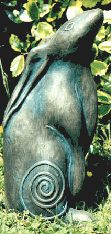Tuesday, April 14, 2015
Tuesday, April 7, 2015
Saturday, April 4, 2015
Origins of the Easter Bunny
The following was first published at The Holiday Spot.
The bountiful Easter bunnies have become the most favorite Easter symbol. It's universal and secular in its appeal. And, most important of all, it relates to Easter historically.
However, one fact has got to be made clear. It is the hare, and not the rabbit, that should be treated as the true symbol of Easter. Though both of them (along with Pikas), belong to the Lagomorpha family and have most of things in common, there are some differences.
If you go by the history, since the ancient times the hare has been a symbol for the moon. Not the rabbit. And, the legend says, the hare never closes its eyes, not even for a single blink! The reason for having such a belief may be rooted in the fact that hares, not rabbits, are born with eyes open.
The ancient Egyptians related hares to the moon. Egyptian name for hare was un, meaning 'open.' And they were beloved to be watching the full moon opened eyes throughout the night.
Also the hare and eggs have to the Anglo-Saxon spring goddess Eostre. Possibly, this is because both of them were regarded to be emblems of fertility.
And this fertility factor may hold the key in making rabbit more familiar as Easter symbol in America, as against the traditional hare. Rabbits beat hares by being more prolific.
The German immigrants, who brought in most of the Teutonic Easter traditions here, made rabbits so popular among the non-German kids. The German children used to have rabbit's nests filled with decorated eggs. They also used to build nests. They looked so attractive that even the non-German kids demanded such gifts on the Easter.
See also the previous posts:
• Eostre: Goddess of New Life Beginnings
• The Goddess Ostara
• Remembering Eostre
• Celebrating Eostre
• The Easter Hare
• Symbol of Enlightenment
• Body and Soul
• Sacred
Subscribe to:
Posts (Atom)























